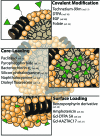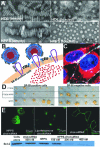Lipoprotein-inspired nanoparticles for cancer theranostics
- PMID: 21557543
- PMCID: PMC3196219
- DOI: 10.1021/ar200017e
Lipoprotein-inspired nanoparticles for cancer theranostics
Abstract
Over hundreds of millions of years, animals have evolved endogenous lipoprotein nanoparticles for shuttling hydrophobic molecules to different parts of the body. In the last 70 years, scientists have developed an understanding of lipoprotein function, often in relationship to lipid transport and heart disease. Such biocompatible, lipid-protein complexes are also ideal for loading and delivering cancer therapeutic and diagnostic agents, which means that lipoprotein and lipoprotein-inspired nanoparticles also offer opportunities for cancer theranostics. By mimicking the endogenous shape and structure of lipoproteins, the nanocarrier can remain in circulation for an extended period of time, while largely evading the reticuloendothelial cells in the body's defenses. The small size (less than 30 nm) of the low-density (LDL) and high-density (HDL) classes of lipoproteins allows them to maneuver deeply into tumors. Furthermore, lipoproteins can be targeted to their endogenous receptors, when those are implicated in cancer, or to other cancer receptors. In this Account, we review the field of lipoprotein-inspired nanoparticles related to the delivery of cancer imaging and therapy agents. LDL has innate cancer targeting potential and has been used to incorporate diverse hydrophobic molecules and deliver them to tumors. Nature's method of rerouting LDL in atherosclerosis provides a strategy to extend the cancer targeting potential of lipoproteins beyond its narrow purview. Although LDL has shown promise as a drug nanocarrier for cancer imaging and therapy, increasing evidence indicates that HDL, the smallest lipoprotein, may also be of use for drug targeting and uptake into cancer cells. We also discuss how synthetic HDL-like nanoparticles, which do not include human or recombinant proteins, can deliver molecules directly to the cytoplasm of certain cancer cells, effectively bypassing the endosomal compartment. This strategy could allow HDL-like nanoparticles to be used to deliver drugs that have increased activity in the cytoplasm. Lipoprotein nanoparticles have evolved to be ideal delivery vehicles, and because of that specialized function, they have the potential to improve cancer theranostics.
Figures






References
-
- Chapman M. J. Animal lipoproteins: Chemistry, structure, and comparative aspects. J. Lipid Res. 1980, 21, 789–853. - PubMed
-
- Acton S.; Rigotti A.; Landschulz K. T.; Xu S.; Hobbs H. H.; Krieger M. Identification of scavenger receptor SR-BI as a high density lipoprotein receptor. Science 1996, 271, 518–520. - PubMed
-
- Gal D.; Ohashi M.; MacDonald P. C.; Buchsbaum H. J.; Simpson E. R. Low-density lipoprotein as a potential vehicle for chemotherapeutic agents and radionucleotides in the management of gynecologic neoplasms. Am. J. Obstet. Gynecol. 1981, 139, 877–885. - PubMed
-
- Cohn E. J.; Strong L. E.; Hughes W. L.; Mulford D. J.; Ashworth J. N.; Melin M.; Taylor H. L. Preparation and properties of serum and plasma proteins. IV. A system for the separation into fractions of the protein and lipoprotein components of biological tissues and fluids. J. Am. Chem. Soc. 1946, 68, 459–475. - PubMed
-
- Goldstein J. L.; Brown M. S. Binding and degradation of low density lipoproteins by cultured human fibroblasts. J. Biol. Chem. 1974, 249, 5153–5162. - PubMed
Publication types
MeSH terms
Substances
Grants and funding
LinkOut - more resources
Full Text Sources
Other Literature Sources

